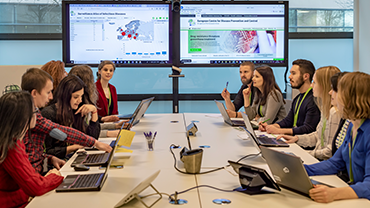2nd Global Influenza Seroepidemiology Expert Meeting (attendance by Invitation)Archived
This meeting followed the First International Seroepidemiology meeting held in Ottawa in February 2011.
This meeting follows the First International Seroepidemiology meeting held in Ottawa in February 2011.
BackgroundOne of the criticisms of surveillance during the 2009 A(H1N1) pandemic is that seroepidemiological data and analyses based on these were not available in a timely manner (1-3). During the past two years, considerable seroepidemiological work was undertaken (4) .However many of the results emerged belatedly, well after when they would be most useful to inform policy-related debates, issues and decisions, such as around that elusive concept ‘severity’. Also the direct comparability of results was limited due to a lack of standardisation in the epidemiological data collected and the laboratory methods used and there are more general concerns over the quality assurance of laboratories (i.e., there was a general lack of standardisation as well as a lack of capacity (5, 6).
Recognizing this gap the Public Health Agency of Canada organised an international meeting in Ottawa in February 2011. An important paper has emerged from the meeting led by Karen Laurie of the World Health Organization Collaborating Centre (CC) for Reference and Research on Influenza in Australia with the other participants and this paper has been submitted to an international journal (7).
The first meeting and Laurie et al paper (7) identified a significant number of steps needed to standardize influenza seroepidemiologic studies. It was therefore agreed to have a follow up Global Meeting and ECDC offered to organise this for December 2011 in Stockholm, as the 6th of a series of ECDC’s Surveillance and Studies in a Pandemic expert meetings that go back to 2006.
This meeting will have a stronger input from European centres but it will still have a global reach with representatives from all the major countries who were at the first meeting from outside Europe, namely Australia, Canada, China and the USA so as to retain the global relevance while at the same time recognising that influenza serology is not something that can be undertaken in every country.
Themes of the meetingPicking up the ‘things to do’ from the Laurie et al paper three themes have been identified for the run up to the second meeting and at the meeting itself:
- Epidemiological standardisation: Lead Maria Van Kerkhove, MRC Centre for Outbreak Analysis and Modelling, Imperial College London, UK. Given the objectives suggested by Laurie et al the intention of the epidemiologic working group is to develop generic seroepidemiologic protocols that can be used in pandemic outbreak settings and for routine serologic collection during non-pandemic seasons, and data collection forms including what would be a minimum list of epidemiological data that should be collected with specimens.
- Preparation and intended outputs: Protocols with recommended data items for consideration at the meeting.
- Laboratory Standardisation and Quality Control: Lead John Wood and Othmar Engelhardt , National Institute for Biological Standards and Control, HPA, UK (NIBSC: WHO Essential Regulatory Laboratory). Given the experience gained by NIBSC’s involvement in laboratory standardisation of vaccine testing and serology, the intention is to determine how the quality of laboratory testing in seroepidemiology can be improved, maintained over time and quickly ensured in a pandemic.
- Preparation and output: A paper reviewing the current state of quality from the NIBSC survey (6) and an accompanying action plan for improvement.
- Sustainability and Links to Seroepidemiology for other Vaccine Preventable Diseases Lead Angus Nicoll – ECDC Routine serological testing for influenza in serum specimens has declined outside the pandemic setting and as part of the regulatory process for influenza vaccines. In the European Union there are now only two countries that have continued to deliver annual serological testing of representative specimens. This is explicable in the context of the difficulties of interpreting these data for seasonal influenza, the technical difficulties of serological testing and their cost. Hence it should not be imagined that such testing can or will be done every year between now and the next pandemic. One way forward is to look to how this work can link to other seroepidemiological work such as that done for vaccine work and for seroepidemiology for other vaccine preventable diseases. Partially this is based on the observation that in the pandemic some of the quickest work in Europe came from countries where there was pre-existing sero-surveillance based on routine work on ‘unlinked anonymous’ specimens in relation to vaccine preventable diseases, STIs and blood borne infections .(7,8)
- Preparation: Summary of lessons learned from country approaches by selected invited participants (e.g. European country serum banks, ‘First Few 100s’ and outbreak approaches.






